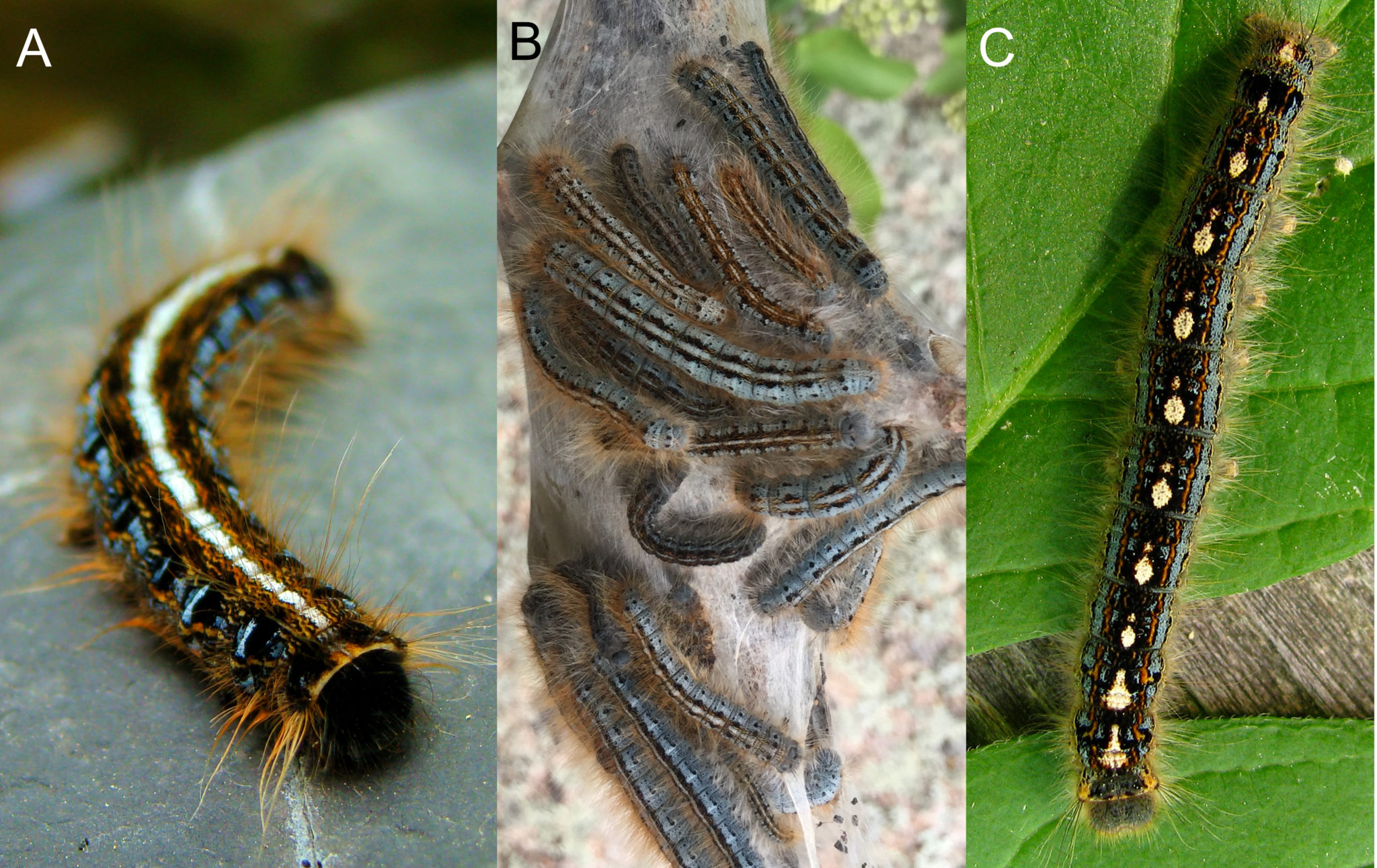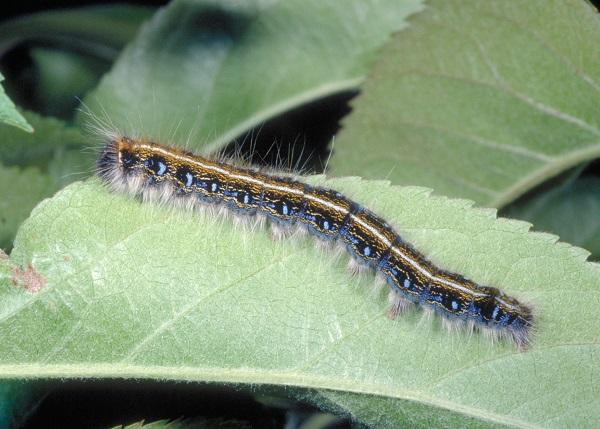The eastern tent caterpillar is of some importance as a pest because it defoliates ornamental trees. These webs are used to protect the caterpillars from predators and the elements.
 The Return Of Tent Caterpillars What S It Means For Your Yard Purdue Landscape Report
The Return Of Tent Caterpillars What S It Means For Your Yard Purdue Landscape Report
The silken sheets they make have pheromones that serve as social cues helping them move around with ease.

Tent caterpillar lifespan. White silken tents in the branches of host plants provide evi-dence of western tent caterpillar presence in spring. All tent caterpillar species have one generation per year. Eastern tent caterpillar webs are built in the crotch and the forks of the host plants limbs.
You can poke holes in the tents with a stick or long-handled apple picker and then twist to gather up caterpillars and webbing. Also the eastern tent caterpillar begins building webs earlier in the growing season than forest tent caterpillars and is among the first insects to come out of their overwintering. Adult forest tent caterpillar moths have a short 510 day lifespan Fitzgerald 1995 and even a short post-mating refractory period could significantly impact the likelihood that a mated male moth would orient to pheromone and be captured in a pheromone-baited monitoring trap.
Larvae live and feed as a colony enlarging the tent as. Larvae do not construct tents Life stage Length of time per individual Time of year Larva Caterpillar Pupa Cocoon Adult Moth 5 days July Egg Egg mass 5-6 weeks Early spring June 3 weeks June 10 months July - early spring. This sort of data can be useful in seeing concentrations of a particular species over the continent as well as revealing possible migratory patterns over a species given lifespan.
You may encounter three species of tent caterpillar in Indiana. A single egg mass results in 50 200 larvae at a time and they mostly move along in a colony throughout this period. Larger nests can be removed by winding them around a stick or pruned out and destroyed.
Some years are definitely worse than others for tent caterpillar infestations. They are black with white keyhole-shaped spots along their back. Immature tent caterpillars are colorful and about 1¾ inches long when fully grown.
Forest tent caterpillar Malacosoma disstria Western tent caterpillar M. Egg cases can be seen easily once leaves drop from trees in fall. Californicum and eastern tent caterpillar M.
The forest tent caterpillar larvae also have a white hairy body with the matured ones growing to 5 65 cm long. When tent caterpillar removal is necessary the nests or egg cases can usually be picked out by hand. Life CycleWestern tent caterpillar has one generation per year.
They have a few long hairs on their bodies mostly along the sides. The life cycle starting with the cocoon spinning and ending with the cocoon part of the cycle again. Eastern Tent Caterpillar Malacosoma americanum Found east of the Rockies and north into southern Canada.
Gypsy moth caterpillars do not produce a web which distinguishes it from web-making caterpillars such as the Eastern tent caterpillar Malacosoma americanum and the fall webworm Hyphantria cunea. Older caterpillars are approximately 15 to 20 inches long. Adults live for only a few days during which they mate and lay eggs and do not feed.
They feed on cherry apple plum willow birch poplar and oak trees. Although tent damage is unsightly infestations rarely threaten the lives of trees. Full grown caterpillars 2 inches long are sparsely hairy and black in.
The webs made by tent caterpillars function as greenhouses that help these early-season feeders stay warm so disturbing the web puts substantial stress on the colony. Every 9-16 years the tent caterpillar. All three species live in groups of anywhere from 40 to 200 individuals that stay together until shortly before they pupate.
The effect of mating on subsequent capture in pheromone-baited. The Western Tent Caterpillar is yellowish-brown with a row of blue and orange spots along their back. The Eastern Tent Caterpillar dark and hairy are popping up all over the state in recent weeks.
These are generally visible shortly after bud burst. Damaged trees however typically recover and refoliate within several weeks. Four species are commonly discussed.
The best time for tent caterpillar removal is early morning or evening while theyre still likely to be in the nest. Our Malacosoma tent caterpillars are native forest pests and despite their voracious appetites our forest trees can usually recover from the damage they inflict. Tent caterpillar outbreaks are cyclical some years worse than others.
Heres what you need to know about these insects if they are. The map below showcases in blue the states and territories of North America where the Forest Tent Caterpillar Moth may be found but is not limited to. The Forest Tent Caterpillar is similar looking to the Eastern Tent Caterpillar.
The silk is produced by glands in the head and the tent provides protection from many natural enemies. The caterpillars have been a bane to Northeastern forests ever since.
 Forest Tent Caterpillars Usually Pose No Threat Local News Victoriaadvocate Com
Forest Tent Caterpillars Usually Pose No Threat Local News Victoriaadvocate Com
The species spreads to new trees when mature moths venture out to lay eggs.
/GettyImages-128110545-59932b8b22fa3a0010612e6b-5c5a18db46e0fb00018215be.jpg)
Where do forest tent caterpillar moth live. Twenty-six species have been described six of which occur in North America and the rest in Eurasia. Tent caterpillars are moderately sized caterpillars or moth larvae belonging to the genus Malacosoma in the family Lasiocampidae. Forest tent caterpillar outbreak is underway in Vermont.
They now reach as far west as Wisconsin and south to North Carolina. The forest tent caterpillar Malacosoma disstria occurs throughout most of the United States and Canada wherever hardwood trees are found. This caterpillar rarely feeds on red maple and conifers such as pine and spruce.
Examples of Missouris lasiocampids include the eastern tent caterpillar Malacosoma americanum forest tent caterpillar M. Some common hosts are aspen alder cherry birch basswood maple and oak. The species spreads to new trees when mature moths venture out to lay eggs.
Widely recognized by their webbed silk tent structures these larval insects can cause mass defoliation in a short period of time. Forest tent caterpillars feed on a variety of broadleaved trees and shrubs although in North Carolina they seem to be most abundant on oaks and sweet gum black gum and tupelo. Forest tent caterpillars FTC Malacosoma disstria and eastern tent caterpillars ETC Malacosoma americanum are native to New York State.
The most commonly defoliated trees in Vermont are sugar maple and white ash but forest tent caterpillar will feed on most deciduous species. Arborists said the population is on the rise right now in West Michigan. While the two species look very similar to the untrained eye Ross says eastern tent caterpillars live together in a larger tent-shaped webs between tree branches and usually feed on the berries and hardwoods close to their homes.
The illustrations and information here will help you to identify which caterpillar is feeding on your trees. Forest tent caterpillars are found throughout the United States and Canada wherever hardwood trees grow. Some species are considered to have subspecies as well.
Red maple is not a host. The insect is native to the region and part of our hardwood ecosystem. The caterpillar for the Forest Tent Caterpillar Moth is often spotted in large clusters on tree trunks with its kin.
That is where they are going to hang out she offers. Forest tent caterpillar larva. The American lappet moth Phyllodesma americana with its wavy-edged gray and rust-colored wings looks like a small dead leaf.
There are three species of tent caterpillars in Kentucky USA. After they have stripped trees the caterpillars feed on shrubs and even vegetables. These three insects are often found feeding on the leaves of hardwood trees easily confused with one another.
They are currently found in 19 states. The caterpillars feed on the tree leaves from the spring until the end of July. Disstria and large tolype Tolype velled a.
Wisconsins forests have evolved with forest tent caterpillars and they are a natural part of the northwoods. Were getting reports now from Wyoming. The eastern tent caterpillar forest tent caterpillar and fall webworm.
It has a varied diet and can be found on deciduous trees in forests parks or backyards. Tent caterpillars live in groups within a silken tent. The first tent caterpillar population boom outbreak on record is from the 1600s.
Other tree species fed upon include birch cherry basswood and ash. Gypsy moths are gradually expanding their territory to the south and west. Forest Tent Caterpillar Malacosoma disstria Hübner is a native insect Found in hardwood forests throughout North America Abundant in eastern North America.
Damage is relegated to the tree or bush where their tent is located. Damage is relegated to the tree or bush where their tent is located. It uses its caterpillar silk to form mats on bark that it.
Widely recognized by their webbed silk tent structures these larval insects can cause mass defoliation in a short period of time. Population numbers vary over the years from very few and not noticeable to many and very noticeable defoliation of trees. Forest tent caterpillar is a native insect.